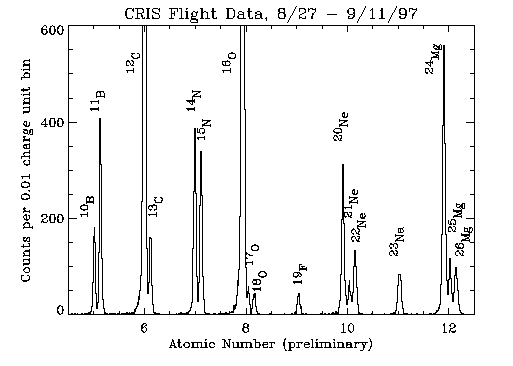ACE News #1: 9/24/97
First Data from the Cosmic Ray Isotope Spectrometer (CRIS)

CRIS was the second instrument aboard ACE to
be turned on, on August 27, 1997. Its purpose is to study the isotopic composition of galactic cosmic
rays with excellent mass resolution and unprecedented collecting power, over an element interval
of 2 <= Z <= 30 (He to Zn) with energies from ~100 to ~500 MeV/nuc. All 60 of
the silicon solid state detectors and their associated electronics in the four ``telescopes''
of CRIS are operating well. The Scintillating Optical Fiber Trajectory (SOFT) hodoscope,
which is used to measure particle trajectories, is achieving excellent position resolution of
~100 µm. We are presently using flight
data to examine SOFT and silicon detector threshold settings in order to optimize
trajectory identification over the entire charge range and to properly sort events
into prioritized event buffers on the basis of their charge and energy.
Shown in the figure is a nuclear charge histogram from CRIS, including events of boron through magnesium
collected between 8/27 and
9/11/97. The C and O peaks extend off the top of the figure, to levels of
3062 and 3560 counts per bin, respectively. More than 20,250 O events are
included in this figure, which were required to satisfy various
consistency cuts and stop in the instrument between the third and the eighth detectors.
This corresponds to an energy interval of about 100 to 250 MeV/nuc for
O. The selection criteria used include less than
half of the available data. Much of the remaining data will be useful once analysis
procedures have been refined. Because the energy signals deposited in the
solid state detectors depend on the atomic mass as well as the nuclear charge of the
particle, element peaks in the ``charge'' histogram show subpeaks due to multiple
isotopes. Two isotopes of B, C, and N and three of O, Ne, and Mg are clearly seen.
Once trajectory calculating algorithms and energy calibrations are further
refined, the resolution should improve further, allowing the
smaller, lower abundance peaks to be more cleanly separated from their higher
abundance neighbors. These data will then provide precise measurements of the
relative abundances of the different isotopes in galactic cosmic rays. The
statistical accuracy of the data already approaches that of the best measurements
from previous instruments.
The CRIS instrument involves investigators from Caltech, the Jet Propulsion Laboratory,
Washington University, and the Goddard Space Flight Center.
.....contributed by Dr. Richard Leske, Caltech.
Last modified 25 Sep 1997,mrt
Return to ACE homepage.
/ACE/ACENews1.html

